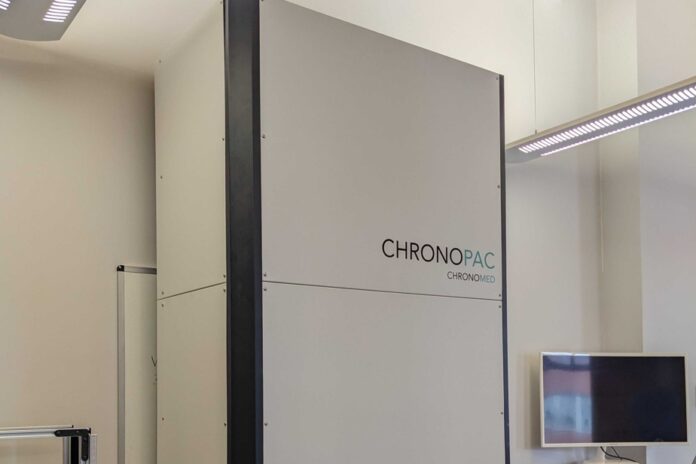Large pharmacies often entrust an automated device with the demanding task of filling the small boxes containing the different tablets that the patient will have to swallow during the week. Small pharmacist owners rarely have the space, both in their premises and in their budget, for these imposing, very useful devices. To meet this need, Chronomed designed the Chronopac, a compact automated cabinet in which a robot carefully and quickly fills two pill boxes at once.
It is precisely to find a solution to this problem that the company Chronomed was founded in Sherbrooke in March 2020 by Maude Laforest and Frédéric Droulers, both holders of a bachelor’s degree in mechanical engineering from the University of Sherbrooke. The need was expressed by a pharmacist friend of Maude Laforest, during a meal at a restaurant.
Designed for small and medium throughputs, the Chronopac is aimed at pharmacies that prepare between 100 and 400 pill bottles per week. Placed on a table or counter, the device measures 1 m wide by 1.6 m high and 60 cm deep.
It is controlled remotely on a computer or mobile device using a cloud application.
The Chronopac robot can hold some 180 medications, divided into as many removable cassettes that have been filled by laboratory technicians.
When rarer medications are prescribed, they are placed by hand in the pill boxes beforehand.
Weekly pill boxes usually take the form of a thin sheet of plastic with 28 cells – or 4 doses of medication per day for a week.
They are placed two by two on mobile trays, identified by intelligent labels.
The trays awaiting filling are placed in a small, equally intelligent shelf, which manages them according to their order of arrival. A light indicates the tray to be loaded into the Chronopac.
“It serves to improve the sequence of operations and avoid errors,” explains Maude Laforest.
When it is its turn, the tray is placed by the technician in a drawer which opens at the bottom of the Chronopac, where it is automatically identified.
A robotic gripper then rises in the device to grab one of the prescription drug cassettes, then comes down to distribute its contents into the boxes of the pill dispensers.
The tray carrying the two pill bottles is then removed for the verification step, “a responsibility of the pharmacist,” she says.
The Chronopac robot has a processing capacity of 25 pill bottles per hour.
The device works three times faster than a laboratory technician, but taking into account peripheral tasks, the preparation time of pill bottles is reduced by 50% compared to strictly manual handling.
The device was designed by Frédéric Droulers.
“He’s my brain, he’s the technical guy,” emphasizes his colleague.
The pillbox robot has some character: its casing was developed in collaboration with Innovation M2, a product development and industrial design firm that specializes in health care technologies. The assembly is carried out at Chronomed, which now has six employees and as many interns.
Because the company is moving cautiously. No question of sugar-coating it.
“We are pre-ordering, you could say,” says Maude Laforest. We are a bit like Tesla because we want to control our marketing and we want to ensure good service to our customers. »
So far discreet about its new product, Chronomed will make the first public presentation at the congress of the Quebec Association of Pharmacists Owners, which will be held on November 16 and 17.
“Starting next year, we would like to start delivering one machine per month, then double that, and then go to three machines per month,” says Maude Laforest.
Chronomed first wants to attack the Quebec market before turning to the Canadian market, then the American market.
The offensive outside Quebec, however, depends on the adoption of pill dispensers, which are not yet very widespread elsewhere in Canada, and even less so in the United States.
“But our contacts with the manufacturers tell us that they are working hard to bring the pill boxes there,” adds the general director of Chronomed. “Especially since pill boxes help with taking medications, which is really an important point for insurers. »















